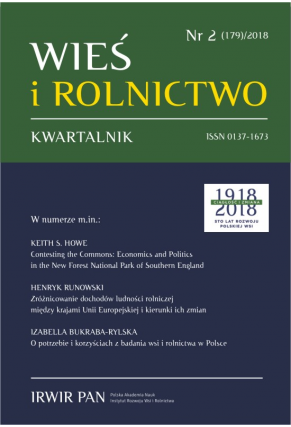Diversification of Agricultural Income among the European Union Member States and the Directions of Its Changes
DOI:
https://doi.org/10.53098/wir022018/04Keywords:
agricultural income, income support mechanisms, income diversification, EU Member StatesAbstract
Income determines the possibilities of satisfying individual types of needs and, as a result, constitutes a determinant of life quality level. This also applies to the agricultural population. The aim of the study is to present the diversity of agricultural income among the European Union Member States, the observed directions of changes in this area and to assess the impact of EU income support mechanisms on the income situation in agriculture. Data used for examination of agricultural income in particular Member States originated from Eurostat, the Central Statistical Office, FADN and literature. The analysis covers a period from Poland’s accession to the European Union, i.e. the first full year 2005 to 2015 or 2016, depending on the available statistical data. The research shows that the Common Agricultural Policy focuses largely on the pursuit of ensuring adequate income from agricultural activity. The applied solutions in the field of agricultural income support in the form of direct payments ensure income increase only to a certain extent, while contributing, among others, to “drainage” of the economic surplus from agriculture. On the other hand, other forms of support are used primarily to compensate for increased production costs on farms, which are incurred, among others, in connection with the supply of public goods. In addition, agricultural income shows considerable variability over time. It is also interesting that in the same years an increase in agricultural income is observed in some Member States and decline in the others. As demonstrated by the analyses conducted, the problem of ensuring agricultural incomes characterized by low variability in time remains unresolved. In this situation, it seems necessary to look for additional sources of income, as well as introduce an agricultural income insurance system, in order to mitigate the effects of changing production and economic situation in agriculture.References
Czyżewski A. (2005). Rolnictwo w procesie reprodukcji: Różne wizje dostosowań rynkowych. W: B. Klepacki (red.). Kwestia agrarna w Polsce i na świecie (s. 127–132). Warszawa: Szkoła Główna Gospodarstwa Wiejskiego.
De Haen M. (1989). Mikro- i makroekonomiczna ocena strategii zmniejszania obciążenia środowiska naturalnego przez rolnictwo. Wykład wygłoszony na Uniwersytecie Hohenheim.
Hergrenes A., Hill B., Lien G. (2001). Income instability among farm households: Evidence from Norway. Farm Management, 11 (1), 37–48.
Hill B. (2012). Farm Incomes, Wealth and Agricultural Policy: Filling the CAP’s Core Information Gap (wyd. 4). Oxfordshire UK: CABI International. DOI: https://doi.org/10.1079/9781845938475.0000
Hill B., Bradley B.D. (2015). Comparison of Farmers Incomes in the EU Member States. Report for European Parliament. DG for International Policies, Policy Department B: Structural and Cohesion Policies. Brussels: European Parliament.
Kłodziński M. (red.) (2008). Wyzwania przed obszarami wiejskimi i rolnictwem w perspektywie lat 2014–2020. Warszawa: Fundacja Klubu 500, Instytut Rozwoju Wsi i Rolnictwa PAN.
Niezgoda D. (2009). Zróżnicowanie dochodów w gospodarstwach rolnych oraz jego przyczyny. Zagadnienia Ekonomiki Rolnej, 1, 36–38.
Phimister E., Roberts D., Gilbert A. (2004). The dynamics of farm income: Panel data analysis using the Farm Accounts Survey. Journal of Agricultural Economics, 55 (2), 197–220. DOI: https://doi.org/10.1111/j.1477-9552.2004.tb00093.x
Poczta-Wajda A. (2017). Polityka wspierania rolnictwa a problem deprywacji dochodowej rolników w krajach o różnym poziomie rozwoju. Warszawa: Wydawnictwo Naukowe PWN.
Rembisz W. (2009). Podstawy rynku rolnego. Warszawa: Wydawnictwo Vizja Press&IT.
Rizov M., Pokrivcak J., Ciaian P. (2013). CAP Subsidies and productivity of the EU farms. Journal of Agricultural Economics, 64 (3), 537–557. DOI: https://doi.org/10.1111/1477-9552.12030
Runowski H. (2014). Kształtowanie się dochodów gospodarstw rolnych w Unii Europejskiej. Prace Naukowe Uniwersytetu Naukowe we Wrocławiu. Agrobiznes: Rozwój agrobiznesu w okresie 10 lat przynależności Polski do Unii Europejskiej, 361, 195–205. DOI: https://doi.org/10.15611/pn.2014.361.20
Soliwoda M., Kulawik J., Góral J. (2016). Stabilizacja dochodów rolniczych: Perspektywa międzynarodowa, Unii Europejskiej i Polski. Wieś i Rolnictwo, 3 (172), 41–68. DOI: https://doi.org/10.53098/wir032016/02
Vrolijk H., Bont K., Phimister E. (2007). Stabilność dochodów w rolnictwie holenderskim: Analiza zmienności dochodów gospodarstw rolnych w oparciu o dane FADN. Maszynopis.
Zegar J. (2001). Przesłanki i uwarunkowania kształtowania dochodów w rolnictwie (seria Studia i Monografie, 107). Warszawa: Instytut Ekonomiki Rolnictwa i Gospodarki Żywnościowej – PIB.
Downloads
Article file downloads
Pages
How to Cite
Issue
Section
License
Copyright (c) 2018 Village and Agriculture

This work is licensed under a Creative Commons Attribution 4.0 International License.










